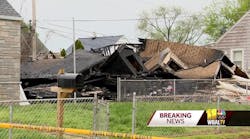For non-critical subjects, sporadic training is fine. But how do you handle the vital, time-sensitive information that must be addressed on a regular basis?
By now, everyone should concur that company level training is a necessity. The fact that you have read beyond the first article supports my assertion, which is great. But what do we do next? Finding common ground, in terms of a basic concept, is only the beginning. Now, we need to devise a detailed plan on how best to proceed.
For non-critical subjects, sporadic training is fine. But how do you handle the vital, time-sensitive information that must be addressed on a regular basis? Often, preparing for such sessions is a pain, because it is not a lot of fun, and the guys are not going to be enthusiastic about this type of training. Without a detailed course of study, it's too easy to skip the dull subjects in favor of those that are simpler and more fun. So we need a plan.
The most important part of implementing any type of change is to know your audience. You cannot expect to go into a fire station, throw down a twenty-pound, three-ring binder, and expect everyone to begin training the first day. You need to implement this training slowly. If you have a very young and eager crew, this process may only take a few months. If you have a very experienced and veteran crew, it may take years to fully implement. You have to know your guys. If you come in without any regard to your people, your training program will be doomed to fail.
First, you must determine the subjects on which you are going to train. In this article, I list the thirty sessions that comprise my schedule. You must tailor the list to accommodate your crew and/or department, and add or delete subjects as necessary. Second, assign a weighted value to each topic. When creating training schedules, I sat down with my crew and we assessed the importance of each subject. As you can see from the list, we are not reviewing high-rise procedures as much as we are focusing on search and rescue in residential structures, because we have no high-rise buildings in our first alarm district. Finally, compose a training schedule. I created a schedule one year in advance, but you can plan individual sessions, a month at a time, if that works better for you.
Below is a list of topics on which my crew trains. Later, individual articles will feature each subject in detail. Due to the fact that not every city uses the same procedures, I will try to include alternative training methods. For instance, when cutting utilities, firefighters in Bridgeport, CT, might employ completely different protocols than those used in Mesa, AZ. Also, whenever possible, I will incorporate some east coast and west coast perspectives and everything in between. Listed in no particular order, my training subjects are as follows:
- Wall breach
- Hose advancement and CAFS
- Splicing and extending attack lines
- Cutting utilities
- Rescuing a downed firefighter & RIT
- Ropes & knots, with tools and their uses
- HazMat procedures
- High-rise procedures
- Entanglement
- SCBA breakdown and emergencies
- Laddering a building
- Extrication
- Thermal imager and reading smoke
- Search and Rescue (commercial)
- Search and Rescue (residential)
- What's on the truck?
- Attic fires and vacant structures
- Room orientation
- Maze
- Apparatus placement and freeway MVA's
- Tilt wall structures
- Ventilation
- Grass fires
- Residential fires with exposures
- Salvage techniques
- Fires in strip malls and bldg construction
- Self-rescue
- Burglar bars and forcible entry
- Sets and reps
- EMS (Shock/Pedi/KED/Internal bleeding/sling and swath/OB/GYN...)
Some of the subjects listed are not the sexiest topics in the world, but they are important nonetheless. And the content is based on and prioritized by the needs of my company, while fulfilling the requirements of my department. However, the same schedule would not be ideal for a swift water team or a technical rescue team. Notice the list does not include command, accountability, or tactics. My department's regular citywide training addresses those topics. In terms of training, my company covers the thirty subjects listed, above and beyond what the department mandates. Due to budget, staffing, and time constraints, many departments cannot provide all the training their personnel need.
Now that you have an overview of the process involved in developing a course of study, how do you decide on which subjects to train? First, review the SOPs or SOGs in order to determine what your department deems important. Then pull out the last twelve issues of Firehouse Magazine, which I am sure you have sitting around the station. Do any specific articles catch your eye? Survey old study material and take notes. Search the Firehouse.com archives, as well as the various other fire service websites. The information is out there, you just have to look for it.
Next, advise your chain-of-command and your crew of your training plans, and solicit constructive feedback on both the schedule and the course of study. Allow them to alter the list of topics and designate the importance of content with a numerical value, as they see fit. For my schedule, I used the numbers one through three on an ascending scale, with a 3-rated topic most important. Then I multiplied the values by 2, and the sum determined how many times we trained on a particular subject in a calendar year. A 3-rated topic is featured in six training segments, during a twelve-month period. Likewise, a 1-rated topic is covered twice a year. I had to play with the numbers to make the schedule fit a calendar year, but the result was well worth the effort. Included is my training schedule. You can see exactly what training we are doing on any given day. Remember, we work 24 hours on, 48 hours off. This will give you an idea just how often we train on each subject.
From my schedule, I've devised additional trainings tasks, which I have expanded into a two-year program. To successfully complete the two-year course of study, my crew and I must fulfill three separate requirements:
- Everyone has to attend each subject a particular number of times, which I have already designated (i.e., participants must attend room orientation ten times out of twelve and laddering a building three times out of six)
- Each participant must plan a major training session for two or more companies, from start to finish, including all related tasks (e.g., gathering necessary props and obtaining authorization from city agencies); and
- Every participant must teach each subject at least once.
Ideally, each task must be fulfilled within the prospective two-year time frame in order for the participant to complete the training program, but you can always expand the time frame. While everyone is expected to assume ownership of their responsibilities, which includes writing and delivering a lesson plan, I will help make contacts. The idea behind this concept is to actively engage personnel not only in the material, but also in the training process. And I believe a program like this will prepare personnel not only for their current job, but also for future promotions. Again, if you decide to try a two-year program, cater my suggestions to your specific needs.
We have now completed all of the boring housekeeping items. Future articles will focus on specific training subjects--the good stuff. Everyone at Firehouse.com is here to help you put the pieces of the puzzle together. You just have to want to put the puzzle pieces together, in the first place, and be willing to work with us.
13-Month Training Schedule (in PDF format):
- July 2006 Training Calendar
- August 2006 Training Calendar
- September 2006 Training Calendar
- October 2006 Training Calendar
- November 2006 Training Calendar
- December 2006 Training Calendar
- January 2007 Training Calendar
- February 2007 Training Calendar
- March 2007 Training Calendar
- April 2007 Training Calendar
- May 2007 Training Calendar
- June 2007 Training Calendar
- July 2007 Training Calendar
- Single document for all 13 months
Please e-mail me at [email protected] with any thoughts or ideas. As always, credit will be given to the individual and their department for any ideas used in future articles.
Related:
- Company Level Training - An Introduction
- Company Level Training - Splicing and Extending an Attack Line
- Company Level Training - The 20 Minute Drill: Part 1
- Company Level Training - The 20 Minute Drill: Part 2
Larry Manasco has been with the Fort Worth, TX, Fire Department for 11 years and has has served as a lieutenant for the past three years. He holds the classification of Fire Officer I and Hazardous Materials Technician. He currently works in one of the busiest engine companies in Fort Worth. He has worked for Firehouse World in San Diego where he was an assistant instructor for FDNY B.C. Salka's "Get Out Alive" H.O.T. class. You can contact Larry by e-mail at [email protected].





